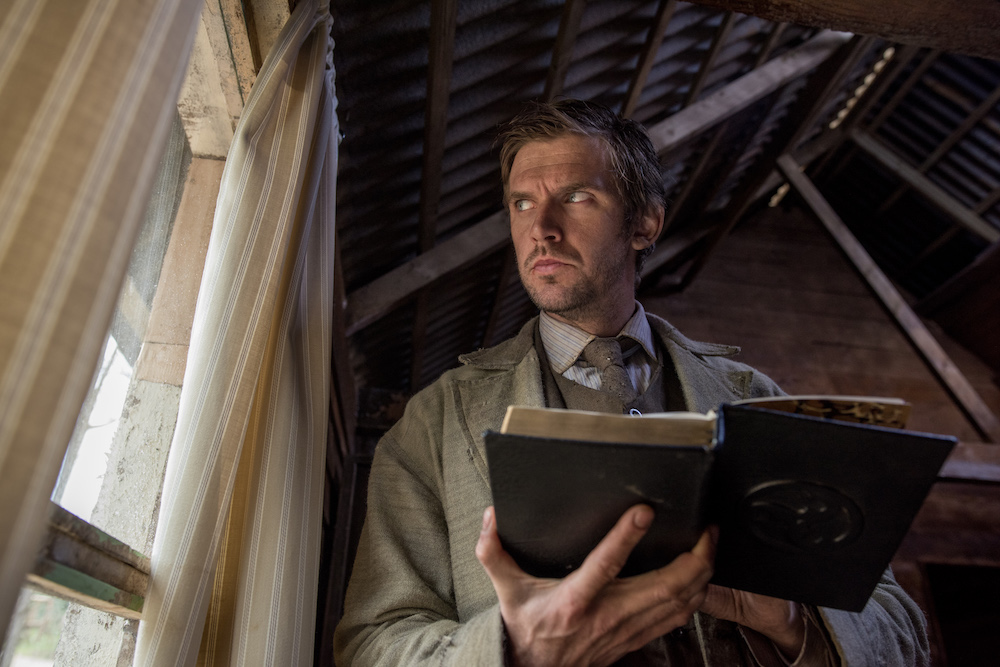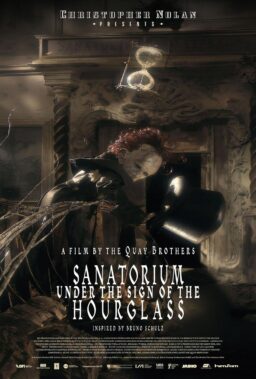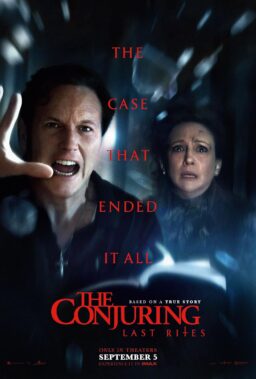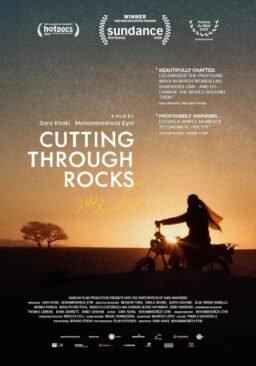With the gory pagan horror film “Apostle,” Indonesian filmmaker Gareth Evans takes a big step away from the martial-arts genre that he put his indelible stamp on in both the “Raid” films and in “Merantau” before that. “Apostle” isn’t Evans’ first commercially released horror film: his contribution to the 2013 horror omnibus film “V/H/S 2” is widely considered to be the best in that movie. “Apostle” feels like more where that grisly short came from, though it also resembles British horror classics like “The Devils,” “Witchfinder General,” and “The Wicker Man,” all of which are acknowledged influences for Evans. In “Apostle,” Dan Stevens plays Thomas Richardson, a disillusioned atheist who travels to the secluded island of Erisden to retrieve his sister Jen from a pagan commune run by Michael Sheen’s Brother Malcolm, a desperate man who worships a mysterious Goddess.
RogerEbert.com spoke with Evans about how he achieved certain practical effects, why his latest film is so brutally violent, and what the film’s violence reflects about real-world toxic masculinity.
Of the your film’s acknowledged influences, “The Wicker Man” is the most irresistible for comparison’s sake, despite big differences between the two film’s lead protagonists. Your film’s protagonist, Thomas Richardson, is a very disillusioned atheist/agnostic, while in Robin Hardy’s film, the woman is very misguided by his faith. There’s that flashback to Thomas’s missionary days in Peking, but I wondered if you could talk about where Thomas comes from.
We kind of played off the idea of that Thomas’s father is devoutly religious: there’s an inscription above his fireplace about religion and suffering and things like that. So in terms of backstory: Thomas would have shouldered a lot of whatever physical abuse occurred in that house when he was a child. And he would have shielded his sister from it, so his sister was protected from that side of their upbringing, in a way. We started there with the backstory and what drew Thomas and Jen very, very close together. At every turn in Thomas’ life, he’s been met with violence. So the Peking Boxer Rebellion, when we came up with that as a flashback sequence, it was something to give us a sense of place and time, that validated my preference for this story to be told at the turn of the Victorian to the Edwardian period in England. We did some research into potentials for what could have been the straw that broke the camel’s back, so to speak, in terms of promises, disillusionment, loss of faith and descent into atheism.
The period is really striking. I’ve read you saying that the film takes place around 1905. Is that right?
Yeah, 1905.
You immediately place us in a different time at the beginning of the film, just using mannered language during the voiceover narration that’s taken from Jen’s letter to her father. Recording voiceover narration is so tricky, especially when it’s supposed to capture a character’s subjective point of view or emotional state. It’s even more tricky when you record somebody’s emotional state through voiceover with such mannered, period-specific language. Where did that letter and the way the characters talk come from? What was recording that voiceover like?
<span class="s1"
<span class="s1" The letter was probably one of the first things we wrote, so when it came to developing the concept for the film … I had the initial seed of a concept, which was a short film that I sort of half-made in 2004/05. That film started with a similar premise, with a woman leaving and the only thing remaining left behind her was an envelope with a letter and a rose petal inside. So those elements carried over into what we ended up doing with “Apostle.”
<span class="s1"
When we were developing this concept—and reconfiguring that seed of an idea into something that would be set in 1905—we started adding more and more layers to it. One of the first things they did was write that letter. That kind of set the tone, in a way, for the world and the way the characters would behave, talk, or speak. It informed the characters’ language and their world. So it was very, very early on we wrote the letter.
In terms of the recording for it, I wish I had a better story for you other than we were in post-production doing the sound mix and we brought Ellen Reese in to do a recording of it. The beautiful thing about Ellen is that she’s such a talented actress that she managed to find, for me, exactly the right tone of internal fear but also something that felt like a little bit of resentment for the people holding her captive. It was a yearning for her safety. It was just a real interesting reading, really. But we didn’t have to do too many takes of that letter read because Ellen nailed it.
What was the name of that earlier short film?
Back then, it was called “Petals,” as in Rose Petal. It was a very, very different thing, but that was playing along the idea of Mother Nature to a degree, though not in the same level we did in “Apostle,” with the Goddess and things. It was more like: me in my early 20s trying to do a short film, thinking I could do a cool straightforward horror film in 10 minutes. It wasn’t that well developed, it was conceptual.
Was it ever released anywhere?
No, we never finished it.

You utilize Dan Stevens’ physicality in ways few other filmmakers have. I wonder if it’s fair to say you wanted the character’s presence—and the audience’s summary understanding of who he is—to mostly come from his body language?
I think a lot of it came from Dan, to be perfectly honest. There were moments with that character where we talked a little bit about his laudanum addiction, his dependency on it, all these things that could make him weak and vulnerable. I feel like audiences will get behind a hero like that. They get behind people who are not necessarily going to power-drive their way through a situation. Dan had to feel like he was somebody who could absolutely endure and persevere through that set of circumstances, and he brought with him this incredible off-kilter performance, this off-kilter body language that made him feel quite jittery and unsettled. When that’s your POV into this universe, and that’s the guy who’s going to take you on that journey, you immediately don’t feel comfortable. You immediately feel like you’re not on solid ground. And so a lot of that came from him.
I’ll give you an example: Dan and I talked about the idea of his slurring of speech. When we were making the film, we shot so much out of sequence that when we were jumping forward through about five or six different stages of the narrative and story order, I noticed that his slur would adapt and shift: it would sometimes be very strong or sometimes start to feel weaker. Initially, everyone’s thinking, “It’s a continuity error,” but we were looking at the margins of the script and it was like he’d beaten it out into, “This is the turning point where Thomas abandons the laudanum and starts focusing on the task at hand, and then he finds an element of sobriety and control.” At that point, his muscles and jaw start to relax and he’s able to talk, to have clearer diction then as well. So yeah, he really did put a huge amount of effort and a lot of work into it, and I think it’s a remarkable performance on his part.
It really is. You mentioned a turning point. For me, watching the film before speaking with you, the big turning point in the film comes in the scene where [hapless Erisden resident Jeremy] is tortured. I love how you visualize that change with this great POV shot where we see the sky from Jeremy’s perspective as the veins in his eye get crushed. I wonder how you achieved that effect both with the camera and those spidery red veins over the camera.
<span class="s1" That was one of those shots where I always felt, “I don’t know if this is going to work.” I’m not a massive fan of POV shots usually. I find them to be quite distracting; they remove you from the story you’re telling. But I thought I could earn it in this instance. So in that whole sequence, when Jeremy’s being carried in towards the table, we insert one POV shot earlier in there, which is an upside-down POV shot, just so it could buy us the later POVs. Without that first shot, I think the second one would’ve felt even more distracting. In terms of the visual look of that scene, we bought ourselves the right to do that shot.
In terms of the technical ability to do that: we had the camera mounted on kind of a tripod head that we could kind of create the sensation of a ratcheting of the camera position so it would gradually feel like it was cranking up to point to the sky. And then everything else from that was all in the hands of Andi Novianto, who has been my VFX wizard since the first film I made. I’ve used him all the way up until now. We had three different VFX companies do work on “Apostle,” and Andi did the vast majority of the shots, and that was one of his shots. The great thing about Andi is he was working remotely from Indonesia at the time, so I had to just give him these little WhatsApp messages, speak to him on the phone, and try to convey what was in my head so he could replicate that. And so it was a case of just trying to explain the veins, the crushing of the veins, the fact that the vision would be slightly cloudy and blurred. And lo and behold, we get a version of the shot that comes in from Andi and it’s absolutely spot-on and perfect for what we wanted to do.
The sequence is upsetting for a couple of reasons, especially because from the start of the scene, we see that torture table getting built, but not the people who build it. It sort of takes a village, but nobody is singled out. From what I’ve read, it seems that production designer Tom Pearce oversaw the making of that torture device. Where did the materials come from?
Yes. First of all: Tom Pearce is an absolute genius. I loved working with him on this, and I felt like he just completely got everything we were trying to do with the film. When it came to the table: I started to design things in little sketches. I did some research into the medieval capital punishment method, which was not a fun afternoon at all. [laughs] It’s pretty dark stuff. Actually, the things that are in real life are far, far, far worse than anything we could have come up with ourselves.
Anyway, I came up with this table and the general gist of it was that all the items on there had to feel like they were organic to the village. So it’s made out of slabs of wood and wrought iron, and the vices would have been things they might have used in the construction of the houses. They would have been used for building tools. And the drill itself would have been used to carve out holes in the wood, again, in order for it to work as construction. So all of those elements, all those things that made up that heathen stand, would’ve been used to build the village, but now assembled in this way it’s to destroy a villager. So it had this nice, creepy, messed-up juxtaposition there that really spoke to us.

The gore in this scene begins with an unblinking, head-on look at the heathen stand’s drill tip as it enters actor Bill Millner’s head. Which is striking since, historically speaking, most gore movies have to shy away from showing actual penetration. Most gore movies show you blood welling up afterwards, but they won’t show you the moment that a murder weapon gets into someone’s skin. Is it fair to say you’d consider it a cheat to cut away before the drill entered Jeremy’s skull?
I think the intent was to reverse viewers’ expectations: I actually didn’t want to show the gore for that sequence. This is one of the stark contrasts between what this film is and what the “Raid” films are. When it came to the “Raid” films, everything is adrenalized, crowd-pleasing. It’s a roller coaster. You can watch an action scene unfold and cheer at the end of it. But in “Apostle,” this sequence was designed to hurt, to not only be physically, but emotionally painful. So I wanted to show you how that device worked, how it functioned, how the mechanism works. What happens when you turn this dial, that dial, whatever. And at the moment it’s about to be used, I’m going to cut away to show the emotional reaction of the people watching it, because you have people close to Jeremy breaking down in hysterics. The sheer devastation of his death is tearing them apart. And then meanwhile, you look at the community, the villagers, and even they are horrified by what they’re experiencing and seeing because none of them wanted it to happen. But what we’re experiencing in that moment is the overthrowing of a system. It’s the installation of a dictatorship through [Brother Malcolm’s second-in-command, Quinn], and everyone’s too afraid to challenge him. Because he’s Brutus; he’s about to overthrow everything. And so in that respect, it was an opportunity to say something about the village and the people there, and not be something that dwelled on purely the violence. So I’m going to put all the violence into (pardon the pun) your head, not on the screen.
How did you achieve that practical effect for this scene? It’s a great magic trick. What materials were used and how did you choreograph, as you said, eliding and implying so much of the violence?
You mean in terms of the drill tip?
Yeah, not just in terms of the blocking of the camera, but also what materials you used for the prop skull.
We did some really, really basic tricks. We were able to do a lot with the combination of Bill’s actual head and a prosthetic head. We would just drill holes at the top of the prosthetic head using rubber drill bits. We also extended the drill bits with CGI so we could have it pierce the skin of Bill’s head. The piercing of his skin is a CG effect from Andi, who is my wizard. A lot of it is clever split screens and keeping the cameras locked so that we can combine a number of different elements to make it feel like you’ve seen everything in one shot. When Quinn does place the rose petal very, very deep inside Jeremy’s head, that’s a combination of two different shots stitched together, so to speak.
The violence in your films always has this element of hyper-realism that I haven’t really seen in other films. There’s a detail in one “Apostle” scene that’s pretty quick, where a guy gets impaled by a whole bunch of spears. The detail that struck me most: you show the guy breathing heavily after he’s been murdered. You just hear him breathing heavily for what feels like an eternity. How integral for you was that detail? And when did you add that effect to the scene, that he’s still alive and we can still hear him panting?
Tom Pearce and I discussed how we were going to get that shot to work, and how we were going to get that effect to work. In fact, we kind of looked at … you know when you get like Snooker cues, where you can kind of screw them together? Basically we kind of worked on that as how we would do the spears going through the body. So we strapped a metal plate on actor Ross O’Hennessy’s body with lots of screw points, so we could screw in the fronts and backs of the spears to get them in the right positions, from the entry point to the exit point. Effectively, those positions were based on the game of Snooker.
As for the idea behind that scene: I really wanted to do a slow shot that would take its time to curve around, so that we see the guy propped up by the positioning of these spears that have gone through his body. I owe a lot to Kiyoshi Kurosawa, who did “Cure.” He did a film called “Charisma,” where there’s a whole sequence where one of the characters is killed with a katana sword that gets pushed through the body slowly and comes out the back of a wicker chair. It’s done in a way that’s almost all one shot. It’s an incredible trick and I was blown away by it, but there’s a stillness to it, a stillness to that person’s death, and that’s what I wanted to achieve. I wanted to get this stillness to this would-be assassin’s death, so that when the camera comes around, it would allow us to see this guy who, even in his dying moments—even though he’s literally seconds away from fading and being no more—every ounce of him wants to put that knife into Malcolm. So when Malcolm does come close, he is still driven by his task at hand, which is to kill this so-called prophet.

There are two more scenes I wanted to single out: the meat grinder table with the cables. From start to finish, did your conception of that scene change at all, or was it exactly as you imagined it?
<span class="s1"
That was a scene that we worked through a lot in pre-production. The mangle table was probably one of the most complicated things we’ve designed in terms of choreography because unlike the more … not straightforward, but unlike hand-to-hand combat where someone’s going to punch, someone’s going to kick, someone’s going to block, someone’s going to throw … in this scene, it’s a fight between two people, but nobody is ever going to really swing a punch or throw a kick. They only come into contact with each other maybe twice during the entire scene.
That whole sequence revolves around the table and how it functions. So before we could even do anything, we had to understand the engineering of it, the mechanics of that table. That was the challenge with that whole sequence, understanding the counterweights, what would happen with the counterweights, how they functioned and played a part of it, how does the lock-lever work. If you push it forward, then the counterweight will drop and push the hooks through the machine at a rapid rate, so it could be used to drag or pull up anything that’s too heavy. Once we sort of understood how that machine worked, that’s when we could start having fun with it, and that’s when we could start figuring, “Oh, OK, so this is the back and forth, this is the prey and the hunter and then the hunter and the prey as the tables get turned.”
Terrible use of the word tables there. But yeah, for me it was a fascinating experience and I was very fortunate that “Apostle” was my first project where I got to work with Jude Poyer, who’s a stunt coordinator who had spent a lot of his time in Hong Kong and came back to the UK to work in the industry. I’ve known of him for a really long time and we’ve become very, very good friends. We have a shared encyclopedic knowledge of Hong Kong action cinema. So he’s kind of become my action designer by choice now, and we’ve been working together lately on the next thing we’re doing. But I was so fortunate to have him and his team on board for this thing, because they really helped get under the hood of that machine and kept asking those questions so even though there were moments where I was happy enough to be like, “Oh, this just works! Let’s just do this!” They would demand that kind of understanding. They were like, “No, we have to know that this machine works. We have to know every aspect of this because the logic has to hold up.” And I’m so glad that they pushed for that, because it just made the scene a hell of a lot better.
The most harrowing scene in the movie has to the one where Thomas is trapped in that claustrophobia-inducing water canal, the one where he first meets the Goddess. Talk about some of the challenges you faced filming that scene.
Let’s just put it this way [laughs], that was nobody’s favorite day of filming. First of all, I always have to apologize to my director of photography, Matt Flannery, because he’s claustrophobic! And in everything we’ve done so far, I’ve put him in really increasingly tight spaces and nightmare situations, and this was no exception. It was a difficult environment to shoot in. We basically built a narrow canal and then we put a lid on top of it, so in a way, it was a coffin with a lot of water in it. That’s very uncomfortable for Dan, who we put in there for about a 10-11 hour day? He wasn’t in there for 11 hours, but he was in and out, in and out, shot by shot, setup by setup.
It’s not fun when you’re dipping yourself into water. No matter how much you try to heat it, it’s always going to feel a little bit cold. And then you go into a tent pumping heat in there, so it’s not good news. That was a day no one was looking forward to and no one wanted to go back and do again. It was hard to light, it was hard to pull focus in there, very difficult to get the shots we wanted to. But yeah, when people are watching it, they don’t really care about what we went through to make it! To work it has to be effective, so if it strikes the level of fear we hope we could with that sequence, then yes … I keep wanting to say it’s worth the suffering of that day. The truth is: everyone suffered except for me! I was pretty comfortable looking behind the monitor saying, “Yeah, let’s go again!” I always feel sort of disingenuous whenever I talk about how difficult life on set is, because for me it’s very, very comfortable!
It seems like the brutality of “Apostle” is, given the context of the story, a reflection of the male-dominated cruelty that the film criticizes. With the exception of [Jeremy’s girlfriend, Ffion] and the Goddess, most of the explicit violence happens to Thomas rather than the other women. Is that a line you didn’t want to cross, to show and exploitatively … brutalize these female characters?
Yeah. I didn’t see the point in showing violence against women. It’s been done, and to be honest, I feel like we’re past that now, or we should be in terms of that kind of exploitative angle. I’m a father raising a daughter, so that kind of stuff doesn’t really have any interest to me, you know what I mean? I don’t want to create content like that. We allude to certain things. Obviously, we don’t completely shy away from it. The film is about, to a degree, how these three men behave. It represents a little of the toxic masculinity that’s been prevailing for the last two or three years, that scares the shit out of me in terms of where we are as a society and where we are globally right now. So there’s those elements of it, and Quinn definitely represents some of that in terms of his attitudes and behavior, and his response and treatment of the women on the island. But I think you can do things about that without having to physically show that and create content that is just transgressive for the sake of being transgressive. It didn’t make sense for this film to be about that. It made more sense for it to be about Thomas’s journey, what he has to endure, and about the fact that he’s endured it in the past. It’s part of his backstory, that he survived that whole experience in Peking and came out the other end, and part of that backstory is to tell the audience, “This is what he’s capable of enduring.” It kind of informs what we can expect him to go through while he’s on this island, and what he’d be willing to put his body through, so to speak.
Based on that reading of Quinn—which is specifically what I was responding to—I wonder if it’s fair to say that you think that the violence that he and the other characters commit (and maybe even in the “Raid” films and “Merantau”) as an extension of toxic masculinity, as you put it?
It’s a combination of those things. To be honest, when it came to writing this film, what I wanted to do is make something that was an adventure-thriller-horror hybrid. I wanted to create this story, but there had to be a subtext to it. There had to be more going on than just, “Guy arrives to save someone and then here’s the roller coaster ride of it.” And at the time of writing it, it’s more like a reflective thing. I didn’t want it to be seen as a social or political message. I’m not using this film to jump on a soapbox and tell the world how I feel. It’s more just that the things that … the layers of fear and violence, whether it’s toxic masculinity and whether it’s man’s ability to corrupt and purge religion in order to further a political game: all of those things were drawn from the headlines, from newspapers, from news items, from what was going on globally, whether it was issues of toxic masculinity or these very public displays of violence and vulgarity. When you saw ISIS orchestrating these horrendous, ritualistic murders in public—it was reflective of that. It was all those things feeding into my fears, insecurities and anxieties that was feeding into the story that I was telling. So it’s kind of more on a subconscious level as opposed to it being, “Here’s what I want to say to the world,” so to speak.












